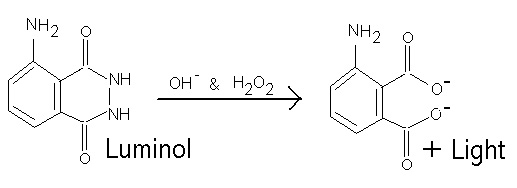Antibody RC20H is specific for phosphotryosine and is coupled to horse radish peroxidase (HRP). The heavy and light chains are engineered to leave out the Fc region and further mutagenised to increase the affinity 10 fold1 . These are expressed in recombinant E.coli.
Luminol releases flashes of visible light ( maximum at 425 nm) in a reaction with hydrogen peroxide catalysed by the HRP. Light is emitted on decay of the singlet intermediate1 (qv). The amount of emitted light is enhanced three orders of magnitude by p-coumaric acid.
-
p-CoumarateIn addition, the enhancer avoids rapid decay of the light intensity so that any delay in putting the filter on film is not critical3. In fact the maximum intensity develops after a few minutes and is relatively stable for 20 minutes, only losing 60-70% of the maximum intensity after an hour. The mechanism by which enhancement occurs is not clear. It does not affect the wavelength of emission so is probably not itself a secondary emitter. It may mediate more efficient transfer of free radicals to luminol3.
Follow this link to a "home-made" recipe for ECL reagents.
1 BD transduction laboratories
2 Synthesis of Luminol
3 Thorpe GHG, Kricka, LJ, Moseley SB & Whitehead TP " Phenol as Enhancers of the Chemiluminescent Horseradish Peroxidase Luminol-Hydrogen Peroxide Reaction: Application in Luminescence- Monitored Enzyme Immunoassays.
